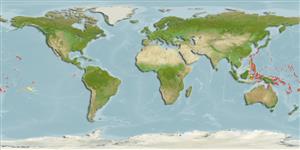Classification / Names
Common names from other countries
Main reference
Size / Weight / Age
Max length : 2.5 cm SL male/unsexed; (Ref. 559)
Environment
Marine; demersal; depth range 0 - 2 m (Ref. 30874)
Climate / Range
Tropical, preferred ?; 30°N - 22°S
Distribution
Short description
Dorsal
spines
(total): 0;
Dorsal
soft rays
(total): 18-19;
Anal
spines: 0;
Anal
soft rays: 8 - 9. Characterized by having blackish spots on cheek; fully united pelvic fins forming disc; rounded caudal fin, about equal to head length; absence of scales and head pores; tricuspid jaw teeth, enlarged outer row; depth of body 6.0 in SL (Ref. 90102); body green with red dorsal, anal, and caudal fins; SL to 25 mm (Ref. 1602).
IUCN Red List Status (Ref. 115185)
Threat to humans
Harmless
Human uses
More information
Common namesSynonymsMetabolismPredatorsEcotoxicologyReproductionMaturitySpawningFecundityEggsEgg development
Age/SizeGrowthLength-weightLength-lengthLength-frequenciesMorphometricsMorphologyLarvaeLarval dynamicsRecruitmentAbundance
ReferencesAquacultureAquaculture profileStrainsGeneticsAllele frequenciesHeritabilityDiseasesProcessingMass conversion
Tools
Special reports
Download XML
Internet sources
Estimates of some properties based on models
Phylogenetic diversity index
PD50 = 0.5312 many relatives (e.g. carps) 0.5 - 2.0 few relatives (e.g. lungfishes)
Trophic Level
2.7 ±0.32 se; Based on food items.
Resilience
High, minimum population doubling time less than 15 months (Preliminary K or Fecundity.)
Vulnerability
Low vulnerability (10 of 100)
Price category
